Medical expert of the article
New publications
Preparations
Fungal sprays
Last reviewed: 04.07.2025

All iLive content is medically reviewed or fact checked to ensure as much factual accuracy as possible.
We have strict sourcing guidelines and only link to reputable media sites, academic research institutions and, whenever possible, medically peer reviewed studies. Note that the numbers in parentheses ([1], [2], etc.) are clickable links to these studies.
If you feel that any of our content is inaccurate, out-of-date, or otherwise questionable, please select it and press Ctrl + Enter.

Mycoses hold the undisputed lead among contagious skin diseases. In the dermatological structure of morbidity, the share of fungal skin lesions accounts for up to 70% of cases. The leading localization is fungal nail lesions, in second place are the feet, and in third place are smooth skin.
As a rule, anthropophilic dermatophytes parasitize on human skin; they are characterized by mild manifestations of the inflammatory process and localization on closed parts of the body (toenails, feet, skin folds), although their location on open areas is not excluded.
For the treatment of fungal infections, especially those located in areas covered by clothing and footwear, the form of release of the drug is very important. Fatty components of ointments and creams, which are mainly prescribed for local use, can cause a greenhouse effect in the area of infection, exacerbation of the inflammatory process and its further spread. In order to prevent such development of the disease, antimycotics in the form of a spray are used to treat the affected area.
Indications fungus sprays
- fungal infections of the feet, smooth skin, hairy areas of the skin, nails;
- epidermophytosis of large folds;
- fungal infection of the stratum corneum of the epidermis ( pityriasis versicolor );
- prevention of fungal infection.
Why is it worth choosing a spray for nail fungus?
Antifungal sprays have proven to be the most effective among other means of getting rid of fungal infections.
The fungus is localized mainly on the toenails, the foot of which is also affected by mycosis. Onychomycosis (fungal nail infection) is quite resistant to the effects of drugs. If ignored, the nail will completely disintegrate after some time. Untreated fungus recurs, and the form of relapse is usually more severe than the primary disease.
Modern sprays against nail fungus not only have a powerful antifungal effect, but also inhibit the spread of fungus. The sprayed preparation remains in the nails for a long time, which significantly reduces the duration of treatment.
A spray for use on the feet, most often covered with socks and shoes, prevents the spread of the disease, as it has a drying, deodorizing and antipruritic effect. At the same time, it does not interfere with the work of the sweat glands. The skin with the spray applied to it functions as usual.
Another advantage of this form of the drug is contactless treatment of the affected area.
And, of course, we must not forget about convenience: measured consumption, compact packaging, ease of use. After using the spray, there are no marks on clothes.
All the sprays described above are suitable for combating fungal nail infections.
Dosing and administration
The preparation is applied to the skin surface in the area of infection, previously cleaned of dead tissue and dried, as well as to the surrounding healthy skin (the affected area must be well moistened).
The duration of therapy and frequency of use of the spray are determined individually, depending on the infectious agent and the general health of the patient.
The condition of the affected skin area noticeably improves after a few days of treatment. If there are no signs of recovery after a week of using the spray, you should inform your doctor (in the treatment of onychomycosis, improvement in the condition usually becomes noticeable after a few months).
Termicon, Lamicon, Lamisil
Antifungal agents for external use. The active component of the sprays is terbinafine, a representative of allylamines, which has the ability to disrupt the process of biosynthesis of the main component of the fungal cell membrane - ergosterol. The fungicidal effect of the drugs consists in the inactivation of the enzyme squalene epoxidase, a catalyst for the third, penultimate stage of ergosterol biosynthesis. Its deficiency with the simultaneous concentration of squalene in the membrane kills fungal cells.
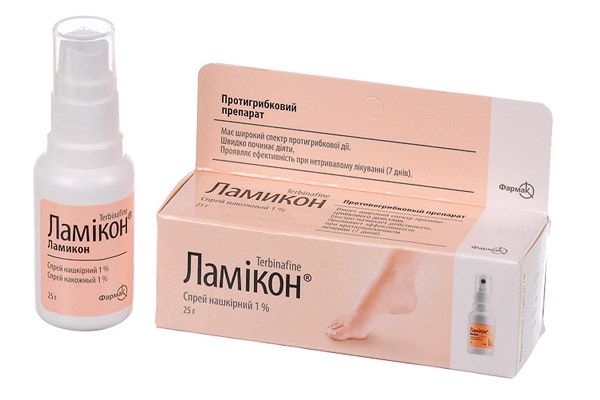
Squalene epoxidase of human skin cells is not susceptible to terbinafine, which explains the selective effect only on fungal cells.
These sprays have a fungicidal effect on the causative agents of epidermophytosis, trichophytosis, microsporia, pityriasis versicolor, candidiasis, as well as on dermatophytes, aspergillus, cladosporium, and scopulariopsis.
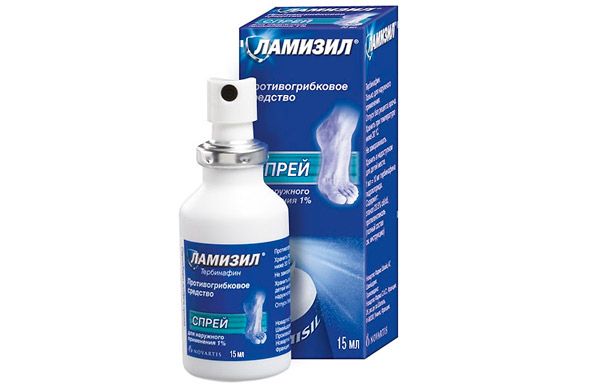
They have either a fungicidal or fungistatic effect on various types of yeast fungi.
Terbinafine absorption with local application is up to 5%. Manifestations of the systemic action of the drug are insignificant.
The use of antifungal sprays during pregnancy and lactation has not been thoroughly studied, so they can be prescribed only if necessary. Studies have not revealed any adverse effects of terbinafine on the intrauterine development of the fetus.
Terbinafine is found in breast milk, so it is better to refrain from using it during breastfeeding.
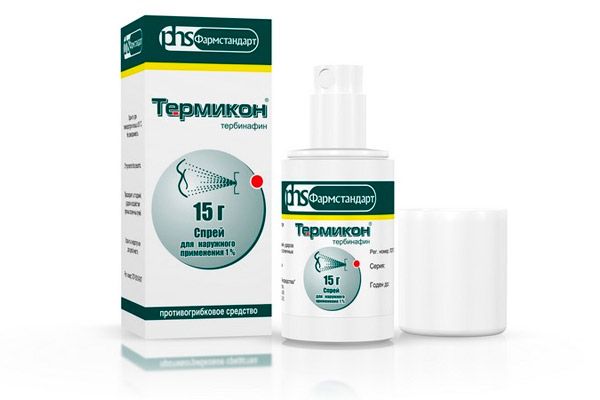
Contraindications for use: allergy to the ingredients of the drug; breastfeeding period; age under 3 years.
Use with caution in cases of: liver and/or kidney dysfunction; alcoholism; neoplasms; metabolic disorders, hematopoiesis, vascular patency of the extremities.
Recommended duration of use: for dermatomycosis and epidermophytosis, the affected area is irrigated once a day for one week; for versicolor lichen - twice a day for one week.
Store for two years at a temperature of up to 25ºС, in a dry place. Keep out of reach of children.
 [ 8 ]
[ 8 ]
Bifosin
Antifungal agent for external use. The active ingredient of the spray - bifonazole has a fungicidal effect on trichophytes, epidermophytes, pathogens of microsporia and candidiasis. It has a fungistatic effect on yeast fungi of the genus Malassezia, aspergilli, scopuloriopsis, corynebacteria, gram-positive cocci (except enterococci).
Bifonazole inactivates one of the catalysts of ergosterol biosynthesis (cytochrome P-450), which causes ergosterol deficiency and accumulation of its precursors in the fungal cell membrane. This process destroys the structure of the cell membrane and destroys the cell.
The spray completely saturates the infected layers of the skin, while not being absorbed into the blood. Six hours after irrigation of the affected area, the level of accumulation of bifonazole in the skin exceeds the minimum effective concentration, which is lethal for the causative agents of dermatomycosis. It is in the skin for up to 2 days. The half-life period is from 19 to 32 hours - depends on the permeability of the skin.
Use of the antifungal spray Bifosin during pregnancy: in the first three months - only if necessary, in the remaining six months - as indicated.
Bifonazole penetrates into breast milk, so it is better to refrain from using it during breastfeeding.
Contraindications for use: allergy to any ingredient of Bifosin, breastfeeding period.
Method and duration of use: The affected area is treated with Bifosin antifungal spray once a day in the evening before bedtime.
The therapeutic effect occurs with continuous use of the spray for:
- fungal infections of the feet and interdigital spaces between the toes – from three to four weeks;
- fungal infections of the scalp – four weeks;
- fungal infections of smooth skin – from two to three weeks;
- versicolor lichen, epidermophytosis of large folds – two weeks;
- superficial skin lesions caused by Candida fungi – from two to four weeks.
Store for two years at a temperature of up to 25ºС, in a dark place. Keep out of reach of children.
 [ 9 ]
[ 9 ]
Side effects fungus sprays
At the spray site, there is a possibility of skin peeling, crusting, itching, burning, pain, irritation, and changes in skin tone.
If the spray gets into the eyes, irritation of the mucous membrane occurs. First aid - rinse the eyes thoroughly with clean running water.
In cases of oral ingestion and swallowing, headache, stomach pain, nausea, dizziness are possible. First aid - activated carbon at the rate of one tablet per 10 kg of weight.
Anti-fungal shoe treatment sprays
Fungal skin lesions are contagious, so in parallel with the treatment process, daily treatment of shoes and clothing that have come into contact with the area affected by the fungus is carried out with antifungal sprays.
The most convenient and effective means of treatment are hygienic sprays for treating shoes against fungus.
Spray Mycostop
Active ingredient: Tetranyl U, a derivative of undecylenic acid. Antagonist of all fungi that infect the foot and toenails. Treatment with Mycostop destroys fungi and prevents the possibility of self-infection from your own shoes. How to use: remove the insoles from the shoes and treat them with spray on both sides, then spray the spray on the inside of the shoe overnight for 3-5 days.

Disinfection of footwear is carried out daily during the therapy period to avoid relapse. All footwear that was worn during the illness should be treated.
Store for two years at a temperature of 10–25 °C.
Dezavid
This spray is an antagonist of dermatophytes, yeast fungi and candidiasis pathogens. Treating shoes with Dezavid prevents re-infection, eliminates other microbes and unpleasant odor.
Does not contain aromatic substances, does not leave marks, does not cause allergies. Can be used to treat shoes made of genuine and artificial leather, suede, textiles and rubber.
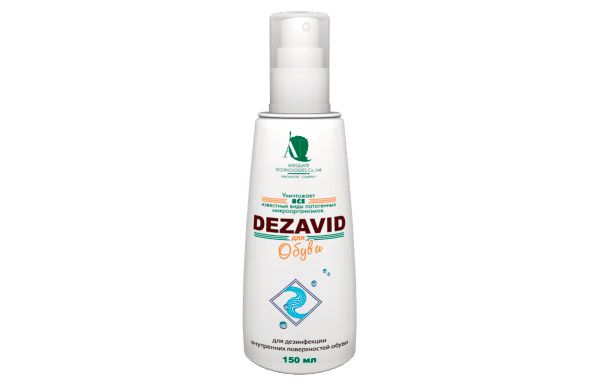
Method of application No. 1: generously spray a piece of gauze, fabric or cotton wool with the spray and treat the inside of the shoes with it.
Option 2. Spray the inside of the shoe with spray. Once it dries, you can use it.
Odorgone Shoes
The spray consists of a mixture of plant extracts, natural oils, distilled water. It has antibacterial and antifungal action. Eliminates unpleasant odor, even animal marks.
The mechanism of action is to precipitate aromatic molecules and absorb them, preventing them from accumulating. After treatment with the spray, there are no marks left on shoes and clothes.
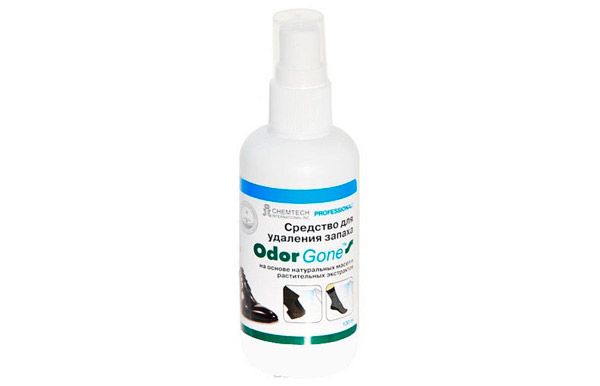
You can treat shoes made of natural and synthetic materials, add to water when washing socks (to prevent fungus) or treat the inside of the sock before washing (during the treatment period). The smell from the treatment disappears after the treated item dries.
Hypoallergenic, non-toxic product.
Using the spray: shake the bottle, spray the inside of the shoes, treat the insoles separately on both sides. Dry in an open space. It is recommended to carry out the treatment before going to bed.
If it is not possible to purchase special sprays for treating shoes against fungus, you can use aerosol antiseptics: Gorosten, Deziskrab, Kutasept, Miramistin.
To disinfect shoes, remove the insoles and spray generously on the inside of the shoe and on the insole on both sides. Place the treated items in a plastic bag, seal and leave for 3-4 hours. Remove the shoes and air dry. Dried shoes can be used approximately 12 hours after the start of the process.
The above description of drugs for the treatment of fungus is recommended only for familiarization with their basic properties. If signs of the disease appear, you must contact a medical institution for diagnosis and treatment.
Therapy for fungal infections sometimes involves complex treatment with different forms of the drug, as well as the use of anti-inflammatory, antibacterial and other agents. Only a dermatologist can prescribe the correct treatment regimen.
Preventive measures include strict adherence to hygiene rules. Failure to comply with the doctor's orders and premature termination of treatment may provoke a relapse of the disease.
Attention!
To simplify the perception of information, this instruction for use of the drug "Fungal sprays" translated and presented in a special form on the basis of the official instructions for medical use of the drug. Before use read the annotation that came directly to medicines.
Description provided for informational purposes and is not a guide to self-healing. The need for this drug, the purpose of the treatment regimen, methods and dose of the drug is determined solely by the attending physician. Self-medication is dangerous for your health.

